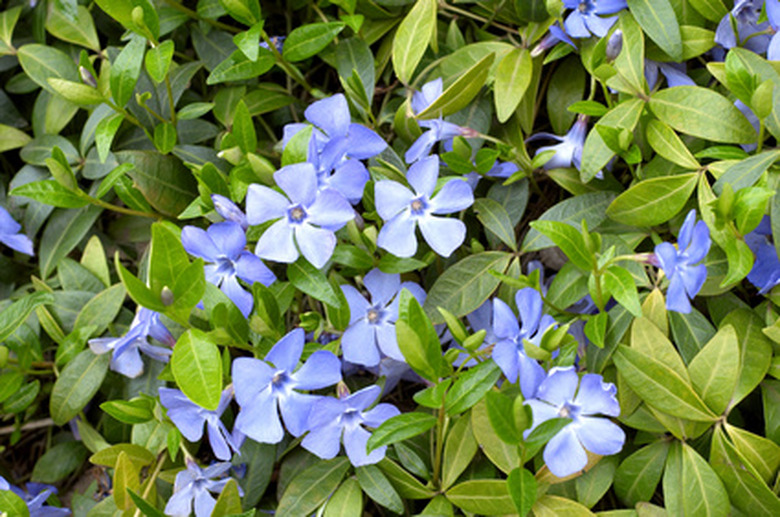How To Winterize Vinca
Vinca minor (common periwinkle) is a perennial groundcover in USDA zones 4 through 9 and an annual plant in colder regions. Although gardeners usually use vinca as a groundcover in shady growing areas, it also makes an attractive trailing plant when you use it in containers. As winter approaches, winterize vinca plants growing in the soil by covering the foliage with a thick layer of mulch. The mulch will prevent harsh winter winds from drying out these perennial plants.
Step 1
Allow the vinca to continue to grow unprotected throughout the autumn months until late autumn. Vinca will continue to thrive throughout most of the autumn weather, including periodic frosts and freezes.
Step 2
Apply 3 to 4 inches of shredded mulch over the entire area where vinca is growing in late autumn. One reason for not applying the mulch too early in the autumn season is that it invites rodents to burrow in the mulch and they may spend the winter within the mulch. Spread the mulch evenly over the vinca, covering the foliage completely.
- Vinca minor (common periwinkle) is a perennial groundcover in USDA zones 4 through 9 and an annual plant in colder regions.
- As winter approaches, winterize vinca plants growing in the soil by covering the foliage with a thick layer of mulch.
Step 3
Remove the mulch the next spring when the temperatures begin to moderate. Vinca will tolerate some freezing temperatures, so removing the mulch in early spring is best for the vinca.
Step 4
Cut back the vinca vines to prune them if they appear overgrown. Most vinca patches will benefit from cutting back to soil level every two to three years. The vinca will regrow with renewed energy after you cut it back.
Winterize Vinca?
Vinca prefers at least partial shade, although it can grow in full sun or full shade. Drought damages vinca, so it needs mulch and at least monthly winter watering in windy and drought-prone conditions. It will also grow in containers and indoors. The low profile makes it convenient to insulate. For greater protection from frost, freezes and snow, completely cover the foliage in 5 to 6 inches of loose mulch. A quick way to winterize vinca for unusual cold snaps in usually temperate climates is to cover vinca when the weather forecast is for freezing temperatures. Vinca generally responds with vigorous growth after being cut back, so if it sustains significant damage from freezing, cut the vines down to the ground and cover with mulch.
- Remove the mulch the next spring when the temperatures begin to moderate.
- Vinca will tolerate some freezing temperatures, so removing the mulch in early spring is best for the vinca.
